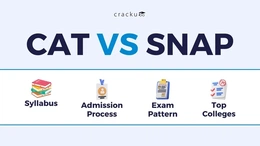CAT Vs NMAT Exam: Aspirants looking forward to pursuing their management education in India are well aware of the two prominent management admission tests - the Common Admission Test (CAT) and the Narsee Monjee Institute of Management Studies Management Aptitude Test (NMAT).
Both these exams serve as gateways to some of the top MBA Colleges in India. However, they greatly differ in various aspects, making the choice between them crucial for aspiring MBA candidates. So for an aspirant to make an informed decision regarding which exam they should choose to take here are the details of their comparative syllabus, difficulty levels, exam patterns, eligibility criteria, and more so that by the end, aspirants have a clearer understanding of which exam might be better suited for you.
Difference between CAT and NMAT Exam
What is CAT?
The Common Admission Test (CAT) is India's top management entrance exam. It is conducted every year by the Indian Institutes of Management (IIMs) on a rotating basis and is the gateway to getting into the prestigious IIMs and over 100 other leading business schools in India. The exam tests aspirants in areas like math, data interpretation, logical reasoning, verbal ability, and reading comprehension. Known for its tough syllabus and competitive nature, CAT requires strong academic skills, strategic thinking, time management, and lots of practice.
What is NMAT?
The NMAT (Narsee Monjee Institute of Management Studies Management Aptitude Test) is an entrance exam conducted by the Graduate Management Admission Council (GMAC) and is primarily accepted by NMIMS and a few other top business schools for MBA programs in India. The NMAT tests aspirants in language, quantitative ability, and logical reasoning. One of its advantages over CAT is that there is no negative marking and aspirants can take the exam 3 times in a testing window. This makes NMAT a flexible and less stressful option for MBA aspirants.
Key Differences
Understanding the key differences between the CAT and NMAT will help candidates to make an informed choice of which exam to take and how to adjust and tailor their prep according to the exams. Here the few of the differences:
| Feature | CAT | NMAT |
| Full Form | Common Admission Test | Narsee Monjee Institute of Management Studies Management Aptitude Test |
| Conducting Body | Indian Institutes of Management | Graduate Management Admission Council |
| Purpose | Admission to Indian business schools (IIMs, etc.) | Admission to NMIMS and few other B-schools |
| Test Format | Computer-based test | Computer-adaptive test |
| Sections | Verbal Ability and Reading Comprehension (VARC) Data Interpretation and Logical Reasoning (DILR) Quantitative Ability (QA) | Language Skills Quantitative Skills Logical Reasoning Skills |
| Order of Sections | Fixed | Flexible |
| Duration | 120 minutes | 120 minutes |
| Number of Questions | 66 (VARC: 24, DILR: 20, QA: 22) | 108 (Language: 36, Quants: 36, Reasoning: 36) |
| Question type | MCQs + TITA | MCQs |
| Scoring Range | 0-198 | 36-360 |
| Negative Marking | Yes | No |
| Attempts Allowed | No restriction | No restriction |
| Frequency | Once a year | Thrice in a test window |
| Test Fees | INR 2400 | INR 3000 + applicable taxes |
| Validity of Scores | 1 year | 1 year |
CAT vs NMAT Exam: Syllabus Comparison
While both exams test candidates on various aptitude skills they do have a slight difference in their syllabus and question types. Here is a comparison of the CAT Syllabus and NMAT syllabus to help aspirants tailor their preparation strategies for each exam.
VARC Vs. Language Skills
This is the verbal sections of both the exams - VARC in CAT and Language Skills in NMAT. Both sections aim to test candidates' skills in English language and their Verbal Reasoning and covers slightly distinct topics and question formats.
| Exam | No. of Questions | Section Timing | Score Range |
| CAT | 24 | 40 mins | max 72 |
| NMAT | 36 | 28 mins | 12-120 |
While topics like Reading Comprehension etc remain same, CAT's VARC difficulty is higher than NMAT and includes both MCQ and TITA type questions while NMAT only tests candidates with MCQ type questions. Also, CAT's VARC put higher weightage on RCs which is the major part of the section while the Language Skills section of the NMAT mainly focuses on grammar and vocabulary.
Here is the key differences in their syllabus:
| CAT VARC Syllabus | NMAT Language Skills Syllabus |
| Reading Comprehension | Reading Comprehension |
| Para-jumbles | Error Identification |
| Odd One Out | Prepositions |
| Para Summary | Para Forming |
| Para Completion | Sentence Completion |
| Analogies |
CAT LRDI Vs. NMAT Logical Reasoning
This is the analytical and critical ability sections of both the exams - LRDI in CAT and Logical Reasoning in NMAT. While LRDI consists of both - Logical Reasoning and Data Interpretation, Logical Reasoning in NMAT only consists of critical reasoning questions.
| Exam | No. of Questions | Section Timing | Score Range |
| CAT | 20 | 40 mins | max 60 |
| NMAT | 36 | 40 mins | 12-120 |
While Analytical puzzles remain same in both the exams, NMAT includes other topics like Verbal critical reasoning in form of Inference, Assumptions, Deductions based questions. The syllabus for NMAT's reasoning section is comparatively more as compared to CAT which is highly concentrated with number based reasoning. CAT's LRDI difficulty is higher than NMAT and includes both MCQ and TITA type questions while NMAT only tests candidates with MCQ type questions.
Here is the key differences in their syllabus:
| CAT LRDI Syllabus | NMAT Logical Reasoning Syllabus |
Logical Reasoning:
| Critical Reasoning
|
Data Interpretation:
| Deductions
|
Analytical Puzzles
| |
Other Reasoning
|
CAT QA Vs SNAP Quantitative Skills
This is the mathematical sections of both the exams - Quantitative Ability in CAT and Quantitative Skills in NMAT. Most of the mathematical topics are same and can be prepared together for both the exams.
| Exam | No. of Questions | Section Timing | Score Range |
| CAT | 22 | 40 mins | max 66 |
| NMAT | 36 | 52 mins | 12-120 |
The major difference here is that while the CAT QA only includes Quant specific topics, NMAT QS includes Quants and Data interpretation and data sufficiency topics as a part of this section. CAT's QA difficulty is higher than NMAT and includes both MCQ and TITA type questions while NMAT only tests candidates with MCQ type questions.
Here is the key differences in their syllabi:
| CAT QA Syllabus | NMAT Quantitative Skills Syllabus |
Arithmetic:
| Arithmetic Properties:
|
Algebra:
| Algebra and Probability:
|
Number Systems:
| Number Properties:
|
Geometry:
| DI & DS: DI-Caselets and Tables DI-Graphs and Charts Data Sufficiency
|
Modern Math:
|
CAT vs NMAT Exam: Difficulty level
When comparing the difficulty levels of the CAT & NMAT, it becomes clear that each exam poses unique challenges and caters to different types of test-takers. While most of the topics retain a common theme, CAT is definitely a notch difficult than NMAT.
While CAT will requiring deep knowledge, analytical skills, and precise time management is known for being notoriously difficult, NMAT is more moderate in difficulty and offers better flexibility and is less stressful. Overall, CAT's high difficulty is because of its complex question types, time constraints, and the need speed across all sections while NMAT's moderate difficulty level is related to its straightforward question types, no negative marking, and the opportunity for multiple attempts within a testing window.
CAT vs NMAT Exam: Exam pattern
The exam pattern for CAT and NMAT differs in terms of structure and time allocation as both the exams serve different type of candidates and have difference of difficulties level. Here is the comparison of their exam pattern.
| Particulars | CAT | NMAT |
| Total Questions | 66 | 108 |
| Total Possible Score | 198 | 360 |
| Total Sections | 3 | 3 |
| Exam Duration | 2 hours | 2 hours |
| Question Types | MCQs + TITA | MCQs |
| Making Scheme |
|
|
CAT Exam Pattern
Here is the section wise exam pattern for CAT:
| CAT Sections | Total Questions | Time limit | Max Score |
| VARC | 24 | 40 minutes | 72 |
| DILR | 20 | 40 minutes | 60 |
| QA | 22 | 40 minutes | 66 |
| Total | 66 | 120 minutes | 198 |
NMAT Exam Pattern
Here is the section wise exam pattern for NMAT:
| NMAT Sections | Total Questions | Time limit | Score Range |
| Language Skills Section | 36 | 28 minutes | 12-120 |
| Quantitative Skills Section | 36 | 52 minutes | 12-120 |
| Logical Reasoning Section | 36 | 40 minutes | 12-120 |
| Total | 108 | 120 minutes | 36-360 |
CAT vs NMAT Exam: Which is Better?
Deciding which exam is better for candidates can depend on various factors like choice of college, academic goals, personal strengths, and test-taking preferences etc. Here are few of the factors on the basis of which one can decide which exam is better suited for them:
- Choice of College: If a candidate's goal is to join top B-schools like IIMs, FMS, MDI-G or SPJIMR CAT should be their preferred choice as these schools only accept CAT scores. Furthermore, CAT is the most accepted exam across Indian B-schools making it the gold standard for MBA admissions.
- Difficulty Level: If the candidate prefers a slightly easier exam that still provides a top notch B-school admission, NMAT might be the better choice. NMAT's moderate difficulty level and comparatively easy questions is suitable for candidates who may find CAT very tough to crack. NMAT also have no negative marking unlike CAT.
- Flexibility and Multiple Attempts: Unlike CAT which can only be given once a year, NMAT provide 3 attempts to take the test in the same year. In this way candidates can re-attempt the NMAT test if they do not get desired score in the first time. Also, while CAT is a rigid test with the set order of its sections, NMAT is adaptive and adjusts the difficulty level according to the candidate's performance in real-time, and allows candidates to chose which section they want to attempt first.
CAT vs NMAT Exam: Eligibility Criteria
While both CAT and NMAT have similar eligibility criteria regarding academic qualifications the minimum percentage requirements may vary. Candidates should carefully check the eligibility criteria of each exam and ensure they meet all requirements.
- Both exams requires a Bachelor's degree in any discipline from a recognized university. For CAT, the minimum score required is 50% aggregate marks or equivalent CGPA and 45% for the reserved category while for NMAT the minimum marks required are 50% across all categories.
- Candidates who are in the final year of their Bachelor's degree or awaiting their results are eligible to apply for both the exam.
- There is no age limit set by any of these exams.
CAT vs NMAT Exam: Preparation Tips
Effective and diligent preparation is required to crack both the exams. While most of the syllabus is same, aspirants can further tailor their preparation to suit the difficulty of CAT and to include the additional topics of NMAT.
For CAT
- CAT's VARC section includes difficult reading passages with complex questions. Candidates need to amp their prep to improve their reading speed and comprehension by regularly reading diverse texts and practicing RC exercises and further practicing VA questions. Best source for this can be to solve PYPs.
- For QA, focus on building a strong foundation of Quants concepts as that is what CAT mostly tests candidates on. Do prepare according to the weightage of each topics and practice solving a variety of quantitative problems to better your problem-solving skills and speed.
- The DILR section of CAT requires logical thinking and analytical skills so candidates need to solve puzzles, caselets, and logical reasoning questions to develop their problem-solving abilities and logical reasoning skills.
- Mock tests are crucial for mimicking the real CAT exam conditions and to evaluate your performance, pinpoint areas of strength and weakness, and focus on enhancing both time management and accuracy skills.
For NMAT
- The Language Skills section of NMAT focuses on grammar, vocabulary, and reading comprehension so practice grammar exercises to strengthen language proficiency and improve your vocabulary by learning new words regularly.
- NMAT's Quantitative Skills section tests basic arithmetic, algebra, and data interpretation like CAT so most of the syllabus can be covered while preparing simultaneously for both.
- The Logical Reasoning section in NMAT includes questions on critical reasoning and logical reasoning. As the syllabus differs for both, do prepare for the additional topics that NMAT includes practice solving questions and analyzing different types of logical problems.
- NMAT allows candidates to take the exam up to three times within a specific testing window. Plan your attempts strategically to improve your scores and use this opportunity to showcase your best performance.
CAT vs NMAT Exam: Marking Scheme
The marking scheme is the most important differentiation factor between both the exams. As CAT and NMAT do not have the same marking criteria.
- While CAT deducts -1 mark for every wrong answer, there is no negative marking in NMAT, making NMAT a safer bet.
- Bot the exams gives 0 marks for un answered questions
- Both the the exams reward +3 marks for every correct answer.
CAT vs NMAT Exam: Coaching
Many coaching offers an integrated coaching programs that cater both the exam preparations as a part of their MBA prep package. By enrolling in such combined courses, aspirants can prepare for both the exams simultaneously as their preparation strategies are tailored to each exam's unique syllabus and format.
Here are some of the top coaching for CAT and NMAT preparations:
- Cracku
- TIME
- IMS
- Career Launcher
- Unacademy
CAT vs NMAT Exam: Top Colleges
Here is the list of top 10 colleges accepting CAT and NMAT scores for admission into their management exam across India.
| CAT-Accepting Top Colleges | |
| IIMs | Management Development Institute (MDI), Gurgaon |
| IITs | Indian Institute of Foreign Trade (IIFT) |
| Faculty of Management Studies | Jamnalal Bajaj Institute of Management Studies (JBIMS) |
| Institute of Management Technology (IMT), Ghaziabad | T.A. Pai Management Institute (TAPMI) |
| SP Jain Institute of Management & Research (SPJIMR), Mumbai | Department of Commerce, Delhi School of Economics |
| NMAT-Accepting Top Colleges | |
| SVKM's Narsee Monjee Institute of Management Studies | XIM University |
| K J Somaiya Institute of Management | T.A. Pai Management Institute (TAPMI), A Constituent Unit of MAHE, Manipal – All MBA Programs, India |
| Indian School of Business (ISB) (Advanced Management Programme in Business Analytics (AMPBA) | ICFAI Business School |
| S.P. Jain Institute of Management & Research(SPJIMR) Global Management Programme – GMP | SOIL Institute of Management |
| SDA Bocconi Asia Center | Great Lakes Institute of Management |













